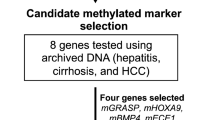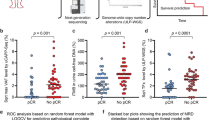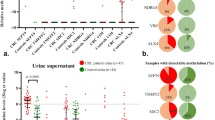Abstract
Improving early cancer detection has the potential to substantially reduce cancer-related mortality. Cell-free methylated DNA immunoprecipitation and high-throughput sequencing (cfMeDIP–seq) is a highly sensitive assay capable of detecting early-stage tumors. We report accurate classification of patients across all stages of renal cell carcinoma (RCC) in plasma (area under the receiver operating characteristic (AUROC) curve of 0.99) and demonstrate the validity of this assay to identify patients with RCC using urine cell-free DNA (cfDNA; AUROC of 0.86).
This is a preview of subscription content, access via your institution
Access options
Access Nature and 54 other Nature Portfolio journals
Get Nature+, our best-value online-access subscription
$29.99 / 30 days
cancel any time
Subscribe to this journal
Receive 12 print issues and online access
$209.00 per year
only $17.42 per issue
Buy this article
- Purchase on Springer Link
- Instant access to full article PDF
Prices may be subject to local taxes which are calculated during checkout


Similar content being viewed by others
Data availability
The cfMeDIP–seq next-generation sequencing data for patient samples that support the findings of this study are available upon request from the corresponding author (M.L.F.) to comply with the ethical and patient privacy regulations of the Dana-Farber Cancer Institute. All requests for raw and analyzed data will be promptly reviewed by the Belfer Office for Dana-Farber Innovations to verify whether the request is subject to any intellectual property or confidentiality obligations. Any data and materials that can be shared will be released via a data transfer agreement.
Code availability
All code used to process the data and conduct the analyses described in the Methods is located in a publicly available GitHub repository at https://github.com/kdkorthauer/cfMeDIPseq-RCC/. This code is made available under an MIT license.
Change history
07 September 2020
A Correction to this paper has been published: https://doi.org/10.1038/s41591-020-1078-y
References
Shen, S. Y. et al. Sensitive tumour detection and classification using plasma cell-free DNA methylomes. Nature 563, 579–583 (2018).
Cohen, J. D. et al. Detection and localization of surgically resectable cancers with a multi-analyte blood test. Science 359, 926–930 (2018).
Dudley, J. C. et al. Detection and surveillance of bladder cancer using urine tumor DNA. Cancer Discov. 9, 500–509 (2019).
Sina, A. A. I. et al. Epigenetically reprogrammed methylation landscape drives the DNA self-assembly and serves as a universal cancer biomarker. Nat. Commun. 9, 4915 (2018).
Shen, S. Y., Burgener, J. M., Bratman, S. V. & De Carvalho, D. D. Preparation of cfMeDIP–seq libraries for methylome profiling of plasma cell-free DNA. Nat. Protoc. 14, 2749–2780 (2019).
Zill, O. A. et al. The landscape of actionable genomic alterations in cell-free circulating tumor DNA from 21,807 advanced cancer patients. Clin. Cancer Res. 24, 3528–3538 (2018).
Pal, S. K. et al. Evolution of circulating tumor DNA profile from first-line to subsequent therapy in metastatic renal cell carcinoma. Eur. Urol. 72, 557–564 (2017).
Hauser, S. et al. Serum DNA hypermethylation in patients with kidney cancer: results of a prospective study. Anticancer Res. 33, 4651–4656 (2013).
Skrypkina, I. et al. Concentration and methylation of cell-free DNA from blood plasma as diagnostic markers of renal cancer. Dis. Markers 2016, 3693096 (2016).
TCGA Research Network. Comprehensive molecular characterization of clear cell renal cell carcinoma. Nature 499, 43–49 (2013).
Lasseter, K. et al. Plasma cell-free DNA variant analysis compared with methylated DNA analysis in renal cell carcinoma. Genet. Med. https://doi.org/10.1038/s41436-020-0801-x (2020).
Schoots, I. G., Zaccai, K., Hunink, M. G. & Verhagen, P. C. M. S. Bosniak classification for complex renal cysts reevaluated: a systematic review. J. Urol. 198, 12–21 (2017).
Gill, I. S., Aron, M., Gervais, D. A. & Jewett, M. A. Clinical practice. Small renal mass.N. Engl. J. Med. 362, 624–634 (2010).
Ewels, P., Magnusson, M., Lundin, S. & Käller, M. MultiQC: summarize analysis results for multiple tools and samples in a single report. Bioinformatics 32, 3047–3048 (2016).
Langmead, B. & Salzberg, S. L. Fast gapped-read alignment with Bowtie 2. Nat. Methods 9, 357–359 (2012).
Li, H. et al. The sequence alignment/map format and SAMtools. Bioinformatics 25, 2078–2079 (2009).
Lienhard, M., Grimm, C., Morkel, M., Herwig, R. & Chavez, L. MEDIPS: genome-wide differential coverage analysis of sequencing data derived from DNA enrichment experiments. Bioinformatics 30, 284–286 (2014).
Law, C. W., Chen, Y., Shi, W. & Smyth, G. K. voom: precision weights unlock linear model analysis tools for RNA-seq read counts. Genome Biol. 15, R29 (2014).
Robinson, M. D. & Oshlack, A. A scaling normalization method for differential expression analysis of RNA-seq data. Genome Biol. 11, R25 (2010).
Friedman, J., Hastie, T. & Tibshirani, R. Regularization paths for generalized linear models via coordinate descent. J. Stat. Softw. 33, 1–22 (2010).
Sing, T., Sander, O., Beerenwinkel, N. & Lengauer, T. ROCR: visualizing classifier performance in R. Bioinformatics 21, 3940–3941 (2005).
Inoshita, M. et al. Sex differences of leukocytes DNA methylation adjusted for estimated cellular proportions. Biol. Sex Differ. 6, 11 (2015).
Colaprico, A. et al. TCGAbiolinks: an R/Bioconductor package for integrative analysis of TCGA data. Nucleic Acids Res. 44, e71 (2016).
Triche, T. J., Weisenberger, D. J., Van Den Berg, D., Laird, P. W. & Siegmund, K. D. Low-level processing of Illumina Infinium DNA Methylation BeadArrays. Nucleic Acids Res. 41, e90 (2013).
Aryee, M. J. et al. Minfi: a flexible and comprehensive Bioconductor package for the analysis of Infinium DNA methylation microarrays. Bioinformatics 30, 1363–1369 (2014).
Moss, J. et al. Comprehensive human cell-type methylation atlas reveals origins of circulating cell-free DNA in health and disease. Nat. Commun. 9, 5068 (2018).
Acknowledgements
This study was conducted with support from Rebecca and Nathan Milikowsky (M.P.), the Claudia Adams Barr Program for Innovative Cancer Research (M.L.F.), a DFCI Medical Oncology grant award (M.L.F. and M.P.) and the H.L. Snyder Medical Research Foundation (M.L.F.). K.K. is funded by the British Colombia Children’s Hospital Research Institute (BCCHRI) Investigator Grant Award Program and the BCCHRI Establishment Award and acknowledges support from Provincial Health Services Authority, the Children’s & Women’s Health Centre of BC and the BC Children’s Hospital Foundation. A.C. is supported by a Canadian Institutes of Health Research (CIHR) Banting Fellowship. T.K.C. is supported in part by the Dana-Farber/Harvard Cancer Center Kidney SPORE and Program, the Kohlberg Chair at Harvard Medical School and the Trust Family, Michael Brigham, and Loker Pinard Funds for Kidney Cancer Research at DFCI. Funding in part by Department of Defense Award W81XWH1910553/Development and Testing of Circulating-Free Methylation DNA as a Prognostic Biomarker for Recurrent Kidney Cancer (PI: T.K.C.).
Author information
Authors and Affiliations
Contributions
P.V.N., J.E.B., S.S., M.P., T.K.C. and M.L.F. conceived and designed experiments. P.V.N., J.E.B. and S.S. performed experiments. P.V.N., J.E.B., S.S., K.K., S.C.B., R.A.I., M.P., D.D.D.C., T.K.C. and M.L.F. analyzed and interpreted data. M.D.M., S.L.C., S.S.W. and G.S. contributed patient samples. A.H.N., S.A.A., Z.B., J.S., G.B., C.R.C., W.P., G.-S.M.L. and M.D.M. collected patient data and samples. P.V.N., J.E.B., S.S., K.K., A.C., S.Y.S., F.B., S.C.B., J.-H.S., R.A.I., M.P., D.D.D.C., T.K.C. and M.L.F. provided guidance and scientific input. P.V.N., J.E.B., S.S., D.D.D.C., T.K.C. and M.L.F. drafted the manuscript. All authors read and approved the final manuscript.
Corresponding authors
Ethics declarations
Competing interests
A.C., S.Y.S., D.D.D.C., T.K.C. and M.L.F. are listed as inventors on patents filed that are related to this method. Disclosures (all outside the scope of the submitted manuscript): M.D.M.: advisory board: Pfizer, Exelixis and Eisai. S.S.W. has also received consulting fees from Public Health Advocacy Institute, GSK, CVS, Roth Capital Partners, Kantum, Mallinckrodt, Wolters Kluewer, GE Health Care, Allena Pharmaceuticals, Mass Medical International, JNJ, Venbio, Strataka, Takeda, Cerus and Pfizer, all outside the submitted work. G.S.: advisory board: Pfizer, BMS, Genentech, EMD Serono, Novartis, Merck, Sanofi, Seattle Genetics/Astellas, AstraZeneca, Exelixis, Janssen, Amgen, Eisai and Bicycle Therapeutics; research support to institution: Boehringer-Ingelheim, Bayer, Pfizer, Merck, Sanofi and AstraZeneca; travel costs: BMS and AstraZeneca; speaking fees: Physicians Education Resource (PER), Onclive, Research to Practice and Clinical Care Options; writing fees: UpToDate; steering committee of trials: BMS, Bavarian Nordic, Seattle Genetics, QED (all unpaid) and AstraZeneca and Debiopharm (both paid). D.D.D.C.: research funding: Pfizer and Nektar therapeutics. T.K.C.: research (institutional and personal): AstraZeneca, Alexion, Bayer, Bristol Myers-Squibb/ER Squibb and Sons, Cerulean, Eisai, Foundation Medicine, Exelixis, Ipsen, Tracon, Genentech, Roche, Roche Products, F. Hoffmann-La Roche, GlaxoSmithKline, Lilly, Merck, Novartis, Peloton, Pfizer, Prometheus Labs, Corvus, Calithera, Analysis Group, Sanofi/Aventis and Takeda; honoraria: AstraZeneca, Alexion, Sanofi/Aventis, Bayer, Bristol Myers-Squibb/ER Squibb and Sons, Cerulean, Eisai, Foundation Medicine, Exelixis, Genentech, Roche, Roche Products, F. Hoffmann-La Roche, GlaxoSmithKline, Merck, Novartis, Peloton, Pfizer, EMD Serono, Prometheus Labs, Corvus, Ipsen, UpToDate, NCCN, Analysis Group, Michael J. Hennessy (MJH) Associates (a healthcare communications company with several brands such as OnClive, PeerView and PER), Research to Practice, L-path, Kidney Cancer Journal, Clinical Care Options, Platform Q, Navinata Healthcare, Harborside Press, American Society of Medical Oncology, New England Journal of Medicine, Lancet Oncology, Heron Therapeutics and Lilly; consulting or advisory role: AstraZeneca, Alexion, Sanofi/Aventis, Bayer, Bristol Myers-Squibb/ER Squibb and Sons, Cerulean, Eisai, Foundation Medicine, Exelixis, Genentech, Heron Therapeutics, Lilly, Roche, GlaxoSmithKline, Merck, Novartis, Peloton, Pfizer, EMD Serono, Prometheus Labs, Corvus, Ipsen, UpToDate, NCCN, Analysis Group, Pionyr and Tempest; stock ownership: Pionyr and Tempest; no leadership or employment in for-profit companies; other present or past leadership roles: Director of GU Oncology Division at Dana-Farber and past President of Medical Staff at Dana-Farber), member of NCCN Kidney Cancer Panel and the GU Steering Committee, past chairman of the Kidney Cancer Association Medical and Scientific Steering Committee; patents, royalties or other intellectual properties: patents filed related to biomarkers of response to immune checkpoint inhibitors; travel, accommodation, expenses, in relation to consulting, advisory roles, or honoraria medical writing and editorial assistance support may have been funded by communications companies funded by pharmaceutical companies (ClinicalThinking, Envision Pharma Group, Fishawack Group of Companies, Health Interactions, Parexel, Oxford PharmaGenesis and others). The institution (Dana-Farber Cancer Institute) may have received additional independent funding from drug companies and/or royalties potentially involved in research concerning the subject matter; a CV will be provided upon request for scope of clinical practice and research; mentored several non-US citizens on research projects with potential funding (in part) from non-US sources and foreign components.
Additional information
Peer review information Saheli Sadanand was the primary editor on this article and managed its editorial process and peer review in collaboration with the rest of the editorial team.
Publisher’s note Springer Nature remains neutral with regard to jurisdictional claims in published maps and institutional affiliations.
Extended data
Extended Data Fig. 1 Flow chart of study samples.
Flow chart outlining the number of cfDNA samples collected, excluded per previously established pre-defined criteria, and included in the analytical cohorts.
Extended Data Fig. 2 Differentially methylated regions in cfDNA between RCC and control samples.
Representative sites of plasma cfDNA methylation gain (left) and loss (right) in RCC relative to controls. Each panel is a 300 base pair window. Each row represents one sample. Row height represents amount of cfDNA methylation at that site.
Extended Data Fig. 3 Correlation of differential methylation in plasma cfDNA and tumor DNA.
Density plot showing the overlap of plasma cfMeDIP-seq DMRs between 69 RCC and 13 control samples with differentially methylated CpGs in tissue from 450 K methylation arrays between 93 peripheral blood mononuclear cell and 324 RCC tumor samples. Each observation (n = 102,852) represents a 450 K methylation array probe (x-axis) that overlaps a region covered by the cfMeDIP-seq assay (y-axis) where the color of each hex bin corresponds to the number of observations in that bin. A simple linear regression line is shown in red. The spearman rank correlation was computed and a 2-sided hypothesis of whether this correlation is equal to zero was carried out.
Supplementary information
Supplementary Information
Supplementary Tables 1–3.
Rights and permissions
About this article
Cite this article
Nuzzo, P.V., Berchuck, J.E., Korthauer, K. et al. Detection of renal cell carcinoma using plasma and urine cell-free DNA methylomes. Nat Med 26, 1041–1043 (2020). https://doi.org/10.1038/s41591-020-0933-1
Received:
Accepted:
Published:
Issue Date:
DOI: https://doi.org/10.1038/s41591-020-0933-1
This article is cited by
-
Diagnostic liquid biopsy biomarkers in renal cell cancer
Nature Reviews Urology (2024)
-
Multimodal analysis of cfDNA methylomes for early detecting esophageal squamous cell carcinoma and precancerous lesions
Nature Communications (2024)
-
A novel DNA methylation signature revealed GDF6 and RCC1 as potential prognostic biomarkers correlated with cell proliferation in clear cell renal cell carcinoma
Molecular Biology Reports (2024)
-
Network approach in liquidomics landscape
Journal of Experimental & Clinical Cancer Research (2023)
-
Liquid biopsy at the frontier in renal cell carcinoma: recent analysis of techniques and clinical application
Molecular Cancer (2023)



